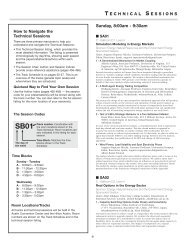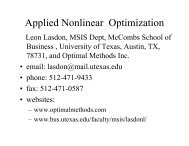Sunday
Sunday
Sunday
Create successful ePaper yourself
Turn your PDF publications into a flip-book with our unique Google optimized e-Paper software.
SA32<br />
2 - Planning Product Availability for an Assortment of Vertically<br />
Differentiated Products<br />
Yalcin Akcay, Koc University, Rumelifeneri Yolu, Istanbul, Turkey,<br />
yakcay@ku.edu.tr, Hari Natarajan<br />
In many industries, firms offer a variety of substitutable products that customers<br />
can choose from. Because product demands are inter-related, managers must<br />
determine inventory policies jointly. Considering the case of a verticallydifferentiated<br />
product assortment, we model and analyze the problem of<br />
determining the optimal inventory policy for a product assortment.<br />
3 - Dynamic Pricing with Strategic Customers under Price<br />
Adjustment Policy<br />
Boxiao (Beryl) Chen, University of Michigan, 1205 Beal Avenue,<br />
Ann Arbor, MI, 48109, United States of America,<br />
boxchen@umich.edu, Xiuli Chao, Hyun-Soo Ahn<br />
We study the dynamic pricing strategy of a monopolist serving heterogeneous<br />
forward-looking customers. The firm offers a price adjustment policy, which<br />
guarantees current buyers a full refund of the difference if they find a lower<br />
future price within a certain time window. We establish the existence of a<br />
subgame perfect equilibrium pricing policy and show that the firm sets different<br />
equilibrium pricing patterns in different regions of system parameters.<br />
4 - Assortment Planning in Multiple Selling Channels<br />
Yiqiang Su, Phd Candidate, University of Florida, Department of<br />
Industrial and Systems Eng, 450 Weil Hall, Gainesville, FL, 32607,<br />
United States of America, ysu1987@ufl.edu, Joseph Geunes<br />
In this research, we consider a clicks-and-mortar retailer who sells goods to endcustomers<br />
through both physical and virtual (e-commerce) channels. The retailer<br />
has limited capacity, and would like to determine the set of products to offer, both<br />
in the local and online stores to maximize its profit from sales during a single<br />
selling season. MNL and Exogenous demand models are used to capture the<br />
customer choice behaviors, and a chance-constrained two stage model is built to<br />
solve this problem.<br />
■ SA32<br />
32- North 223- CC<br />
Quality Control and Learning in Manufacturing<br />
Contributed Session<br />
Chair: Gabriel Burnett, The Boeing Company, P.O. Box 3707,<br />
MC 13-98, Seattle, WA, 98124, United States of America,<br />
gabriel.a.burnett@boeing.com<br />
1 - Changing the Paradigm for Education in Quality<br />
Thong Goh, Professor, National University of Singapore,<br />
1 Engineering Dr 2, Blk E1A #06-25, Singapore, 117576,<br />
Singapore, isegohtn@nus.edu.sg<br />
Quality education has been “customer oriented” for many decades. Some ideas<br />
and techniques have become outmoded in the modern society. It is time that<br />
some paradigm shift was made in quality management education. This needs to<br />
be realized soon if the new generation of quality practioners are to find<br />
themselves relevant.<br />
2 - A Hybrid Inspection Strategy for Rapid Deployment of<br />
Automated Inspection Technology<br />
Patrick Spicer, General Motors, General Motors R&D Center,<br />
Warren, MI, 48093, United States of America,<br />
patrick.spicer@gm.com, Mike Wincek, Jeffrey Abell, Hui Wang<br />
New manufacturing processes for advanced automotive propulsion systems (i.e.<br />
batteries or fuel cells) may not have well-developed automated inspection<br />
technologies at first. In this presentation, a hybrid inspection strategy is described<br />
that enables a manufacturer to begin with human inspection and gradually<br />
phase-in automated inspection technology until the inspection task is completely<br />
automated. This strategy has been successfully implemented in an automotive<br />
assembly plant.<br />
3 - Continuous Improvement in Cellular Manufacturing: The Case<br />
of an Electronics Manufacturer in Japan<br />
Tomoaki Shimada, Associate Professor of Operations Management,<br />
Kobe University, 2-1 Rokkodai-cho, Nada-ku, Kobe, 657-8501,<br />
Japan, shimada@b.kobe-u.ac.jp, James Ang, Hisashi Kurata<br />
This study is case-based research that analyzes continuous improvement in<br />
cellular manufacturing at an IC recorder manufacturing plant in Japan. The study<br />
provides practical insight into how to make an effort to improve the productivity<br />
of one-worker cellular production over time. The implementation results indicate<br />
that workers reduced the takt time by about 19%, and confirm that continuous<br />
improvement plays an important role in cellular manufacturing from the<br />
perspective of human dimensions.<br />
INFORMS Phoenix – 2012<br />
66<br />
4 - Investigation of Learning Curves in Production Systems<br />
Gabriel Burnett, The Boeing Company, P.O. Box 3707, MC 13-98,<br />
Seattle, WA, 98124, United States of America,<br />
gabriel.a.burnett@boeing.com, Adam Graunke<br />
We investigate the behavior of learning curves in the context of large scale<br />
production systems. Learning curves are used extensively when planning<br />
production systems. We demonstrate the implications of a variety of commonly<br />
held assumptions. We then provide an empirical study to analyze which events<br />
(i.e. rate breaks, technology insertion, derivative products, etc) create a significant<br />
departure from the global learning curve and how such events could be modeled<br />
in the future.<br />
■ SA33<br />
33- North 224 A- CC<br />
Sustainable and Responsible Operations<br />
Sponsor: Manufacturing & Service Oper Mgmt/Sustainable<br />
Operations<br />
Sponsored Session<br />
Chair: Jose Cruz, Associate Professor, University of Connecticut,<br />
School of Business, Storrs, CT, 06269, United States of America,<br />
jose.cruz@business.uconn.edu<br />
1 - Closed-loop Supply Chain with Quality Differentiation<br />
Patrick Qiang, Assistant Professor, Pennsylvania State University,<br />
Great Valley, Philadelphia, PA, United States of America,<br />
qzq10@gv.psu.edu<br />
We model the CLSC that captures consumer’s heterogeneous valuation on the<br />
remanufactured product and the new product. The model captures the interaction<br />
among various players, including manufacturers, retailers, and consumers.<br />
Numerical examples are used to provide managerial implications.<br />
2 - A Dynamic Model to Study Sustainable Business Policies in a<br />
Closed Loop Supply Chain<br />
Sudip Bhattacharjee, Associate Professor, University of<br />
Connecticut, Storrs, CT, United States of America,<br />
sbhattacharjee@business.uconn.edu, Jose Cruz<br />
The sustainability of a closed loop supply chain depends on the economic viability<br />
of all actors in the chain. We model the phenomenon analytically and create<br />
dynamic models to study key factors that impact profitability of partners in the<br />
chain. We find that product design, marketing and related actions of up-market<br />
producers significantly influence the ability of down-market recyclers to survive.<br />
We discuss environmental and revenue implications of several policy scenarios.<br />
3 - Operationalizing Sustainable Production Strategies Subject to<br />
Diminishing Resources<br />
Manuel Nunez, Associate Professor, School of Business, UConn,<br />
2100 Hillside Road Unit 1041, Storrs, CT, 06269, United States of<br />
America, mnunez@business.uconn.edu, Hsiao-Hui Lee<br />
We develop a two-stage dynamic model to analyze different sustainability<br />
strategic decisions such as starting a recycling program or developing alternative<br />
technologies to replace a diminishing resource. We investigate the impact of the<br />
parameters on the optimal decision and discuss how to operationalize the<br />
decisions in the supply chain.<br />
4 - Mitigating Global Supply Chain Risks through Corporate<br />
Social Responsibility<br />
Jose Cruz, Associate Professor, University of Connecticut,<br />
School of Business, Storrs, CT, 06269, United States of America,<br />
jose.cruz@business.uconn.edu<br />
We develop a decision model that captures supply side disruption risks, social<br />
risks, and demand side uncertainty within an integrated global supply chain and<br />
corporate social responsibility (CSR) modeling and analysis framework. We<br />
investigate the effects of CSR activities in a global supply chain and compute the<br />
equilibrium product flows, prices, and levels of social responsibility activities. The<br />
results show that CSR activities can potentially be used to mitigate global supply<br />
chain risk.



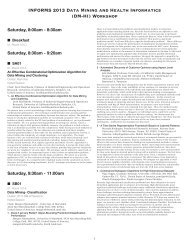
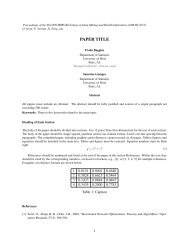
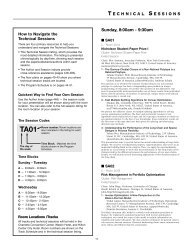
![[PDF] Charlotte Back Matter](https://img.yumpu.com/17933057/1/190x245/pdf-charlotte-back-matter.jpg?quality=85)

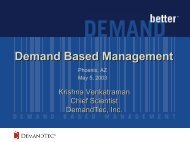
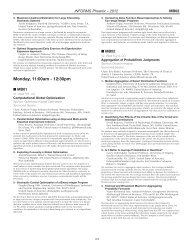
![[PDF] ALIO Back Matter](https://img.yumpu.com/17932960/1/190x245/pdf-alio-back-matter.jpg?quality=85)
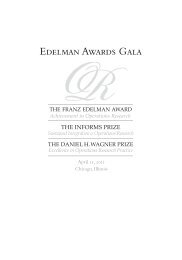
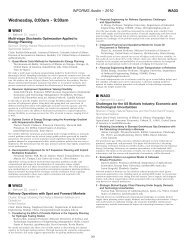
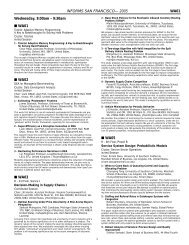
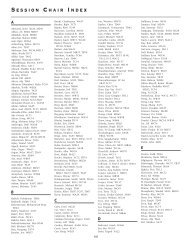
![[PDF] Monday, 8:00am - 9:30am](https://img.yumpu.com/17932954/1/190x245/pdf-monday-800am-930am.jpg?quality=85)
